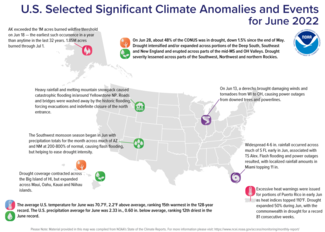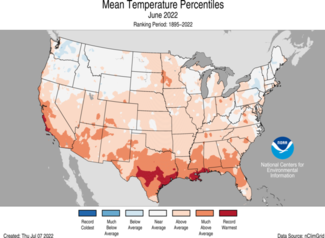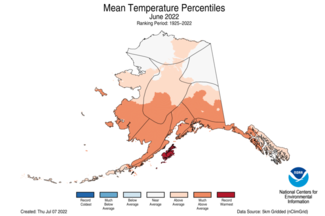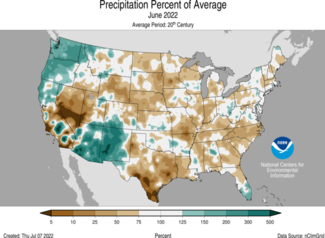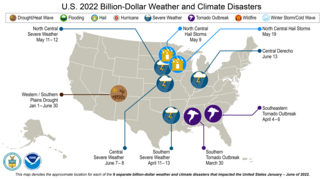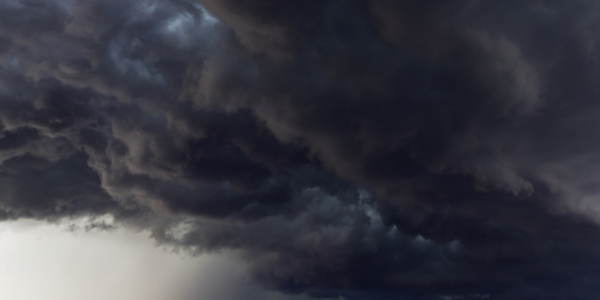Exacerbated by a record-dry June, Alaskan wildfires grow at near-record pace
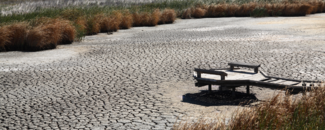
Key Points:
- The average temperature of the contiguous U.S. in June was 70.7°F, which is 2.2°F above average, ranking 15th warmest in the 128-year record. Temperatures across much of the southern half of the Lower 48 as well as from the northern Plains to the Ohio Valley were above average.
- June precipitation for the contiguous U.S. was 2.33 inches, 0.60 inch below average, tying with 1930 for 12th driest in the historical record. Precipitation was above average across portions of the Northwest and Southwest. Precipitation was below average in the Great Basin, from the central Rockies to the Great Lakes, across the Deep South and from the mid-Mississippi Valley to the Southeast.
- Integrated across the state, precipitation across Alaska ranked driest on record for June and was 0.04 inch less than the previous record set in 1934.
- There were nine billion-dollar weather and climate disasters identified during January-June, the fifth-highest disaster count in the 43-year record for this year-to-date period. These disasters consisted of eight severe storm events and one drought event.
- The wildfire season continues as large fires burn across portions of the South and Southwest and have grown rapidly across Alaska. Across all 50 states, more than 3.9 million acres have burned from January 1 through June 30 — nearly 2.3 times the average for this time of year.
- According to the June 28 U.S. Drought Monitor report, 47.7 percent of the contiguous U.S. was in drought. Due to monsoon rains, parts of the Southwest saw a reduction in extreme to exceptional drought, but drought conditions erupted and/or expanded across parts of the mid-Mississippi Valley and Southeast. Puerto Rico has been in drought for a record 81 consecutive weeks.
Other Highlights:
Temperature
Above-average warmth, associated with a ridge of high pressure, dominated much of the contiguous U.S. during June. Several Southern Tier states had a top-10 warmest June on record including Texas, ranking fifth warmest on record for the month. This is the third consecutive month of extreme heat across Texas, which resulted in a ranking of warmest on record for the April-June period.
Averaged over the first half of the year, the contiguous U.S. temperature was 48.7°F, 1.2°F above the 20th-century average, ranking in the warmest third of the January-June record. Temperatures were above average from California to the Plains and from the central Gulf Coast to New England. Florida and California ranked seventh warmest and South Carolina ranked eighth warmest for this period. Temperatures were below average in parts of the Northwest and the Upper Midwest.
The Alaska statewide June temperature was 52.2°F, 3.0°F above the long-term average. This ranked as the ninth-warmest June in the 98-year period of record for the state. Temperatures were above average across much of the southern half of the state with record warm temperatures across Kodiak Island. Temperatures were near average across much of the North Slope and Northeast Interior divisions. Sitka had its warmest June on record while Anchorage and Kodiak were second warmest. For the first time on record, Anchorage reported daily high temperatures of at least 60°F every day during June.
The year-to-date temperature for Alaska was 24.4°F, 3.0°F above the long-term average, ranking in the warmest third of the record for the state. Above-average temperatures were observed across most of the state and were near average across much of the North Slope and Northeast Interior divisions.
Precipitation
The Pacific Northwest received above average precipitation in June associated with multiple atmospheric river events during the first half of the month and the Southwest received an abundance of precipitation associated with the return of the monsoon season during the second half of June. New Mexico ranked fifth wettest on record. Washington and Oregon ranked seventh and eighth wettest on record, respectively. A dominant ridge of high pressure across the central and eastern U.S. resulted in below-average precipitation totals for the month. North Carolina ranked second driest on record for June and Nebraska seventh driest.
The January-June precipitation total for the contiguous U.S. was 13.84 inches, 1.47 inches below average, ranking in the driest third of the record. Precipitation was above average across portions of the Pacific Northwest, northern Plains, Great Lakes and in pockets from the mid-Mississippi Valley to the Northeast. Precipitation was below average across much of the West and Deep South, as well as portions of the central Plains and Southeast during the January-June period. California ranked driest on record while Nevada and Utah ranked second and third driest for this six-month period, respectively. Texas ranked sixth driest.
Alaska precipitation was near average across the North Slope and portions of the Panhandle, but was generally dry to record dry across much of the state in June. Talkeetna had its lowest June precipitation total since at least 1932. Over the most recent three-month period (April-June), Alaska was also record dry as precipitation averaged across the state was 0.68 inch lower than what was received during the same period in 1954 — shattering that record.
Despite the record-dry conditions of the last three months across Alaska, precipitation averaged across the state for the January-June period ranked in the wettest third of the record and was generally above average across much of southeastern Alaska and near or below average for much of the rest of the state.
Other Notable Events
As of July 1, the largest fire on record in New Mexico, the Hermits Peak Fire, had consumed nearly 342,000 acres and was 93 percent contained. The Black Fire, New Mexico’s second-largest wildfire on record, burned through 325,000 acres and was 70 percent contained as of July 2.
1 million acres burned in Alaska by June 18 — the earliest such occurrence in a year than anytime in the last 32 years. By July 1, 1.85 million acres had been consumed — the second-highest June total on record and the seventh-highest acreage burned for any calendar month on record for Alaska.
The East Fork wildfire in the Yukon River delta region of Alaska is the largest tundra fire on record (since the 1940s) in the Yukon delta at 166,000 acres. Smoke from the ongoing fires created visibility and health concerns across much of mainland Alaska during June.
The elevation of Lake Mead, the nation’s largest reservoir, is nearing closer to the dead pool, the elevation that prevents the water from flowing downstream from the dam, in late June. On June 30, the lake elevation was 1,043.02 feet above sea level — the lowest elevation since the 1930s when the lake was first filled, and within 150 feet of the dead pool.
Drought
According to the June 28 U.S. Drought Monitor report, 47.7 percent of the contiguous U.S. was in drought, down about 1.5 percentage points from the end of May, but up 2.4 percent in the last week of June. Drought intensified and/or expanded across the Deep South, Southeast and New England and erupted across portions of the mid-Mississippi and Ohio Valleys. Monsoon rains helped to lessen the drought intensity across parts of the Southwest. Several atmospheric river events aided drought reduction and/or elimination in portions of the Pacific Northwest and the northern Rockies. Drought expanded across Alaska and Puerto Rico and contracted across the Big Island of Hawaii during June.
Billion-Dollar Weather and Climate Disasters
The nine individual billion-dollar events of 2022 include: three general severe weather events, two tornado outbreaks, two hail storms, a derecho event and a broad-area drought event. For this year-to-date period, the 2022 disaster count ranks fifth-highest behind 2017, 2020, 2011 and 2021.
Despite the above-average number of disasters during the first half of 2022, only a small number of fatalities has been reported associated with these events.
With an estimated cost of $2.2 billion, the costliest event to-date was the Southern Severe Weather event that occurred April 11-13.
Since these billion-dollar disaster records began in 1980, the U.S. has sustained 332 separate weather and climate disasters where overall damages/costs reached or exceeded $1 billion (based on the CPI adjustment to 2022) per event. The total cost of these 332 events exceeds $2.275 trillion.
Monthly Outlook
According to the June 30 One-Month Outlook from the Climate Prediction Center, above-normal temperatures are likely across the central and southern Plains and leaning above-normal from the Rockies to the East Coast as well as across southeastern Alaska. Below-normal temperatures are favored along the Pacific Northwest coast. Parts of the Southwest and from the Gulf Coast to the mid-Atlantic coast as well as the western half of Alaska have the greatest chance of above-normal precipitation whereas below-normal precipitation is favored across portions of the Great Basin and the central and southern Plains. Drought is likely to persist over much of the West with some improvement expected across the Southwest and along the west-central Gulf Coast. Drought development is likely from the Lower Mississippi Valley to the Midwest. Outside of the contiguous U.S., drought is likely to persist or develop across portions of Alaska, Hawaii and Puerto Rico, although recent heavy rains may mitigate drought on the eastern portion of Puerto Rico.
According to the One-Month Outlook issued on July 1 from the National Interagency Fire Center, parts of Alaska and Hawaii, eastern Washington to central California, portions of the southern Plains and the east-central Florida coast to the Carolina coast have above normal significant wildland fire potential during July.
This monthly summary from NOAA’s National Centers for Environmental Information is part of the suite of climate services NOAA provides to government, business, academia and the public to support informed decision-making. For more detailed climate information, check out our comprehensive June 2022 U.S. Climate Report scheduled for release on July 14, 2022.

